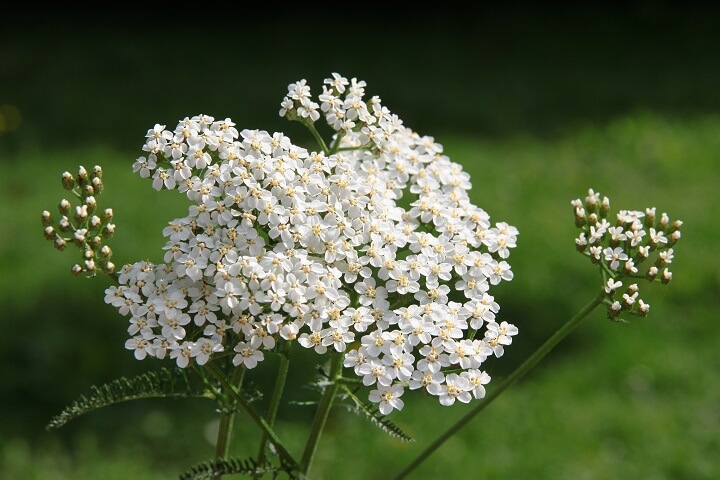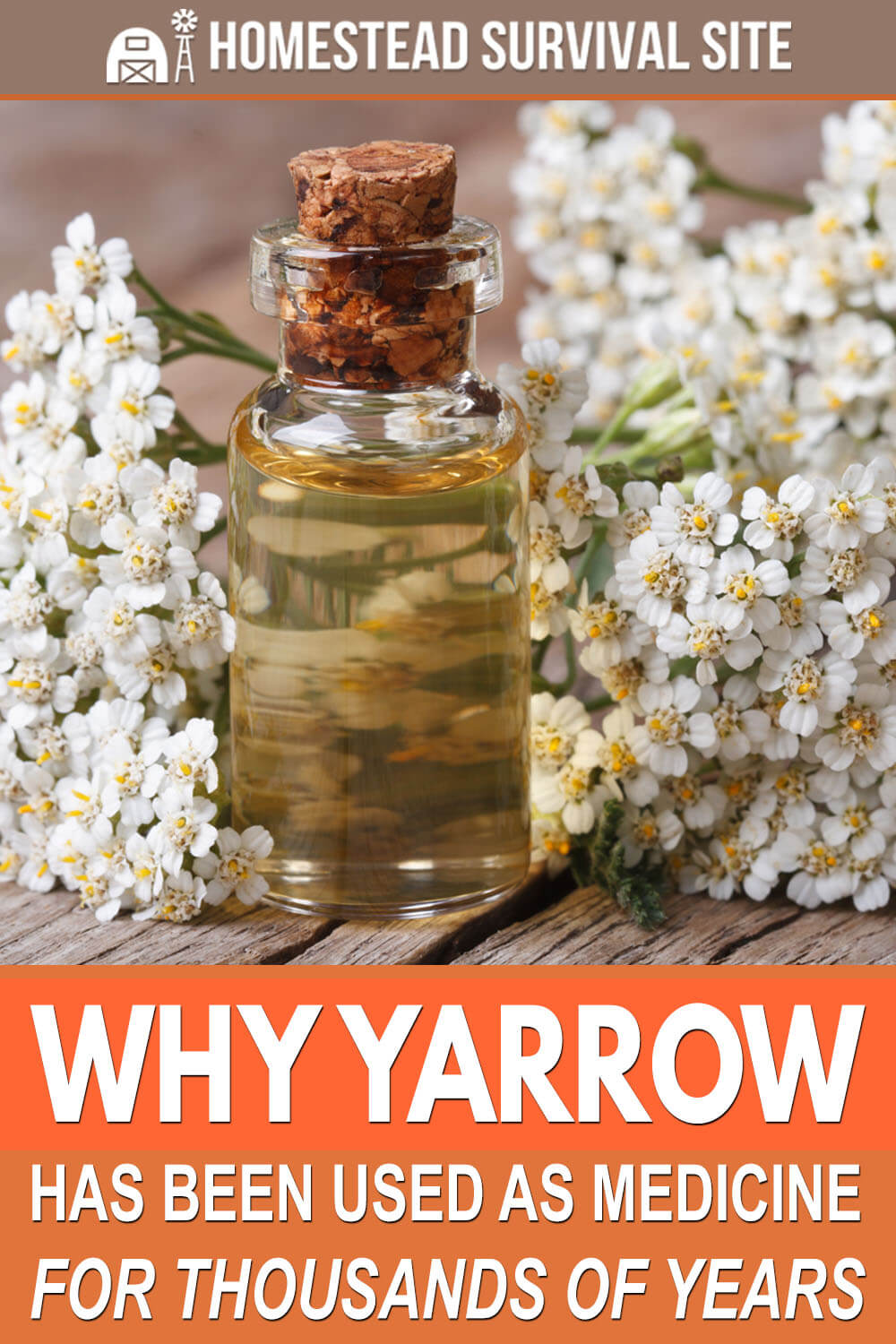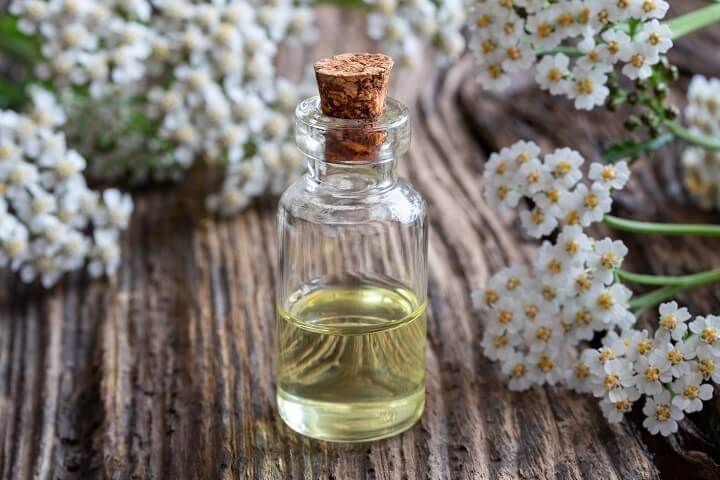Estimated reading time: 8 minutes
Disclaimer: I am not a medical doctor and nothing in this article should be taken as medical advice. Please talk to your doctor before using any of the herbs and/or remedies mentioned in this article. Yarrow is one of the oldest medicinal herbs, dating back thousands of years and used for various ailments. It's a member of the aster family, along with chamomile and chrysanthemums; it's quite a famous and beautiful flower family. You can find yarrow growing in gardens and along roadsides and throughout meadows.
Yarrow didn't start as a native North American plant. It originated in Europe and western Asia, but it was introduced and naturalized to Australia, New Zealand, and North America over time.
Want to save this post for later? Click Here to Pin It On Pinterest!
Are you interested in learning more about this ancient medicinal herb? Let’s take a peek at its history and how you can use it today.
The History of Yarrow
Legend tells us that yarrow, technically called Achillea millefolium, was named after Achilles, a Greek mythical hero, who used this herb to stop bleeding wounds on his soldiers during the Trojan war in 1200 B.C. Herbal legend says that Chiron, a centaur, taught Achilles how to use this herb.
Whether or not that is true, the world will never know, but we do know that healers placed rolled yarrow leaves into the nose of those who were bleeding throughout medieval times. Achilles might not have used it, but yarrow did have a place on the battlefield as a clotting agent.
That’s not the only place we see yarrow in history. We know that the Persians used yarrow to stop hemorrhaging, treat pneumonia, and heal wounds as detailed throughout their accounts.
The name “yarrow” is an Anglo-Saxon word that means “to prepare” because it was used as a curative herb. Even today, there are modern medicinal uses for yarrow. It's used as a curative remedy for malaria, jaundice, and liver disorders throughout the world.
Yarrow was even used during World War II in England when the country experienced a shortage of needed medical supplies. Officials encouraged citizens to forage for wild yarrow to supplement the depleted supplies required for their soldiers.
Growing Yarrow in Your Backyard Garden
No herb garden is truly complete without yarrow. Many view it as a weed, but when grown purposefully and tended well, it is a gorgeous addition that will attract pollinators to your home.
Many people think that yarrow only comes in white, but it actually grows in multiple shades, such as pink, purple, red, and yellow. It can be like a yarrow rainbow in your yard, but white is the most commonly chosen color you will see growing wild. No matter the color that you select, they all have the same medicinal properties.

Here is some basic information about how to grow yarrow in your herb garden.
- Understand that yarrow is a hardy perennial with rigorous growth that will push out its neighbors unless you prune and trim as needed.
- Plant yarrow in the spring or early summer once the danger of frost has passed.
- It prefers to grow in a lot of sunlight, but yarrow can handle partial shade. However, if the spot has too much shade, it will cause the stems to become floppy and fall over.
- While yarrow grows in nearly any soil, including poor dirt, it prefers loamy and sandy soil, but its pH varies.
- It's best not to put too much fertilizer or compost into your soil because it will cause rapid, overenthusiastic growth. Then, your plants will require staking. Find an area with poor soil and add just a bit of compost to give the plants a starter boost.
Harvesting Yarrow Properly
The great thing about yarrow is that it's an easy to grow herb that isn't picky about conditions. Harvesting is even easier; you need to let the plant grow to maturity. The leaves, stems, and flowers all contain medicinal properties, so don't waste any of the plants.
- When the flowers open fully, harvest each stem with a sharp pair of garden scissors or a garden knife. Harvest all the way down to the ground.
- Hang the stems with the flower head attached upside in your house or somewhere dry for several days or up to a week.
- After that, you can crumble up the herb and store it in an airtight container. Yarrow stays good for up to one year.
- You can harvest and use the root, but you need to allow the plant to mature for 2-3 years before harvesting it. Another option is to gather small bits of the root each year. It will need to dry for at least a week before storing it.
What Ailments Yarrow Can Treat
Just because yarrow has a long history doesn't mean it's not still a valuable medicinal herb today; it indeed is. No medicinal herbal cabinet is complete with yarrow. It has many uses that we can even use today; you might be surprised by this extensive list of uses.
If you’re skeptical about its usefulness and safety, yarrow has been the topic of many studies, focused on its safety and effectiveness in various ailments. One study suggested that yarrow's antispasmodic property could help decrease problems such as irritable bowel syndrome.
Here are some of the amazing benefits of using yarrow:
- Anti-inflammatory
- Anti-microbial
- Anti-spasmodic
- Diuretic
- Eases digestive problems and discomfort, such as bloating or flatulence
- Ease menstrual discomfort and postpartum bleeding
- Lowers blood pressure
- Promotes better sleep
- Reduces a fever
- Reduces anxiety
- Reduces inflammation in the gums
- Relieves a toothache
- Stimulates blood flow around the pelvic region
- Stops bleeding
- Treat hemorrhoids
- Treats pneumonia
- Treats rheumatic pain
- Wound treatment
Be Careful If You’re Pregnant
It’s recommended that pregnant women avoid taking yarrow by mouth because it can affect the menstrual cycle. Some evidence suggests that yarrow could cause a miscarriage, so it’s best to avoid it entirely.
As for breastfeeding, there isn't any reliable information about its safety. It's best to speak to your IBCLC or avoid it entirely while breastfeeding as well to be on the safe side.
The Ways to Prepare Yarrow as a Medicinal Herb
Yarrow can safely be taken internally and externally, so that means there are various ways you can use this herb in your everyday life. I prefer to use a yarrow tincture, but I know some people prefer a poultice, especially for an external injury.
Here are several ways that you can use yarrow as a medicinal herb.
Infused Oil
You can use infused oils to treat wounds, soothe inflamed and irritated muscles, heal bruises, and reduce varicose vein swelling. Preparing infused oils is easy, using cold-pressed extra virgin olive oil, but only high-quality neutral carrier oil will work just as well.
Take some dried leaves and flowers, and put them in a glass jar. You want to try to fill the jar as much as you can with the dried herbs. Then, cover the herbs with a carrier oil. Typically, you want one part dried herb to four parts oil, but don't feel pressured to measure it. Seal the jar and keep it somewhere dark for several weeks to cure, shaking it daily to move the mixture.
After 4-6 weeks, strain out the oil and use it as is, or you can use it to make a salve.
Poultice
An easy way to make a poultice is to mix just enough hot water with your ground-up yarrow to create a paste. Then, you apply it to the affected area, such as the external wound. Some people chew up the herb to make it a paste or use a mortar and pestle.
Salves
Salves are similar to lotion but thicker and made with beeswax. You can use them on your skin, rubbing over inflamed muscles or external wounds that need to help. There are thousands of recipes for herbal salves, all helpful in their own way.
Teas
Some people steer away from yarrow tea because it has a mildly bitter flavor, but it’s also sweet and aromatic at the same time. A bit of honey can hide the bitter flavor, and it’s a fantastic addition to your herbal medicine cabinet.
You can use yarrow tea to reduce mild symptoms associated with colds and flu. It also can help with minor digestive problems, such as an upset stomach.
Tinctures
Tinctures can be a potent way to take an herb, and they do take time to prepare, but it's worth it. You need the dried leaves and flowers ground up and 80 proof or higher alcohol.
Fill a glass jar with the dried herbs and cover with the alcohol of your choosing. The ideal ratio is 1:5 – 1 ounce of the dried herbs and 5 ounces of alcohol. Leave the mixture to infuse and soak for 6-8 weeks in a cool, dark place. Then, strain it and place the tincture in a bottle.
Final Thoughts
Yarrow has long been used as a medicine due to its effectiveness and usefulness. We have evidence that it's been used for centuries for dozens of ailments, and its uses still continue today. Try using yarrow as a medicinal herb in your home to see why it's been used for thousands of years.
Like this post? Don't Forget to Pin It On Pinterest!












